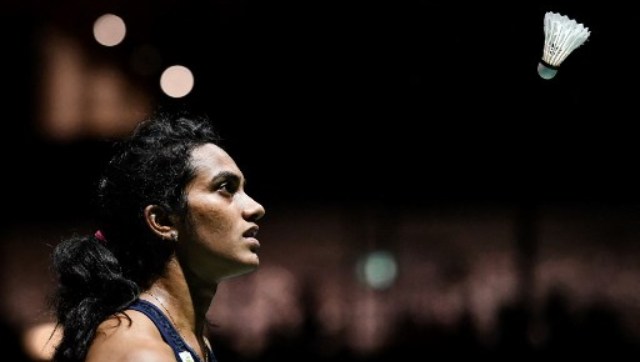Despite her heroics at the World Badminton Championships since 2013, and at the Olympics in 2016, PV Sindhu has a mediocre record at the All England Open, for long considered the blue riband of the shuttle sport. The 25-year-old Indian ace has a mere two semi-final finishes to her credit, let alone a spot in the final at the most prestigious tournament until the advent of the official World Championships in 1977. There were signs this time that Sindhu would finally grab the crown that has eluded her for eight years. After comfortable victories over Malaysia’s Soniia Cheah and Denmark’s Line Christophersen, the Indian played one of the finest matches of her career to
beat Japan’s Akane Yamaguchi , considered one of the medal contenders at the Tokyo Olympics. The manner in which Sindhu fought tooth and nail, and stayed with the speedy, ultra-fit Yamaguchi right through the course of their 76-minute encounter, showed that she had not only exacted revenge for her loss at the semi-final stage in the 2018 edition of the competition, but also appeared to have recovered a lot of the determination and verve she had revealed when grabbing the 2019 World Championship title in Basel. Alas, in the penultimate reckoning the next day, Sindhu came a cropper against the talented young Thai girl, Pornpawee Chochuwong, touted as the logical successor to the 2013 world champion from her country, Ratchanok Intanon. The Indian had beaten Chochuwong during the group stage of the delayed 2020 World Tour finals in Bangkok, in January this year, but could not reproduce that form, and succumbed meekly by a 21-17, 21-9 scoreline. There were two major reasons for Sindhu’s abject semi-final surrender. One was the scheduling of the All England event that allowed the Indian barely 14 hours to rest and recover before the semi-final. The second, and more important, factor was the stiffness and muscle soreness due to the build-up of lactic acid in the legs that Sindhu would have experienced on the morning after playing a gruelling quarter-final against an attritional Yamaguchi who revelled in interminable rallies and excelled in the art of wearing an opponent down. Sindhu was unable to reproduce the sparkle of the previous day; she was visibly slower in her movements all around the court, and her bending to retrieve Chochuwong’s overhead crosscourt shots appeared laboured. “If lactic acidosis sets in, there is a severe deprivation of oxygen to the brain, and carbon dioxide takes over,” says Dr Satish Kudchadkar, a practitioner of sports medicine. “In such a situation, the thinking power and control over the game become haphazard.” Chief national coach Vimal Kumar, who oversees training at the Dravid Padukone Centre of Excellence in Bengaluru, was in full agreement with the diagnosis, but stressed that the lactic acid accumulation could be removed by ice baths and/or cryotherapy. [caption id=“attachment_9441981” align=“alignnone” width=“640”] World Champion PV Sindhu is yet to win an All England crown. AFP/File[/caption] “Three minutes in a cryogenic chamber at -140 degrees can take care of the lactic acid built-up,” said Vimal. “The top tennis players employ these methods to recover after their matches lasting five and six hours. At this level, badminton needs these methods, but they are neglected. To a certain extent, badminton is sadly not yet a professional sport!” Yet, cryogenic chambers are available in India, and at rates that the top players would find fairly affordable. It has been ascertained that a three-minute session in a cryo chamber costs Rs 2,000 which, for an international badminton player, is nothing more than pocket money. Another well-known coach, Roshan Lal Nahar, who was with the Indian team during the 1983 World Championships in Copenhagen, lamented the absence of importance given to “recovery training” by the current crop of Indian coaches. He stressed that shuttlers needed to do several circuits of outdoor short-interval training to ensure swift recovery between rallies. “During a lengthy rally, the pulse rate can go up to 180 beats per minute, and it is essential to bring it down to 70-80 beat levels before the next rally is played,” asserted Nahar. “Otherwise, when the lungs are starved of oxygen, there cannot be the required body and brain coordination for the next rally. “Our Indian players have traditionally suffered in this regard, compared to the players from south-east Asia, who lay huge emphasis on short-interval training, where you really push your body hard to bring the pulse rate down during the short intervals permitted between successive circuits. “In the 1980s, Ami Ghia would have been unbeatable at world level, but for the fact that she lacked raw physical strength, and that her recovery between rallies was not good enough to allow her to play the next rally at full pace. It is the same with Sindhu – she is forever gasping for breath, resorts to time-wasting tactics, and her body language is terrible.” Be that as it may, Sindhu lost a golden opportunity of adding the All England title to her bulging kitty. She now has a full month to prepare for her next tournament, and barely four months remain before the Tokyo Olympics, where she will seek to convert her 2016 Rio silver medal to gold. Sindhu would no doubt have viewed the All England final between Chochuwong and Nozomi Okuhara. She would have noticed that, despite having played a gruelling and exhausting semi-final against Ratchanok Intanon the previous day, Okuhara was supremely untroubled in her movements around the court in the final. It would be worth Sindhu’s while to imbibe the Japanese’s training techniques that allowed such tremendous recovery. It is to be hoped that India’s golden shuttler at least gives the “armchair critics” a fair hearing, and confers with her coaches (including the most recent recruit from Korea, Park Tae Sang) to revamp her training to increase her agility on court and her recovery between rallies, besides working on her body language.
Short-interval recovery training and quick sessions in a cryogenic chamber are some of the remedies experts suggest for PV Sindhu to maintain her intensity and cope up with the unforgiving schedule.
Advertisement
End of Article


)

)
)
)
)
)
)
)
)



